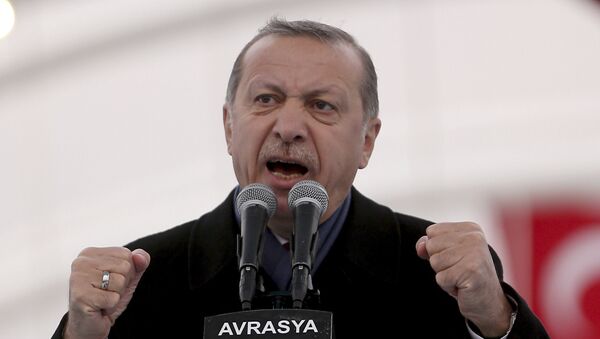Speaking to officials at the presidential palace on Thursday, Erdogan said that the recent drop in the value of the country's national currency was caused by Turkey's enemies.
Admitting that the country's economy has "some problems," Erdogan insisted that these could not explain the lira's dramatic 25% drop against the dollar and the euro over the last six months. Since January 1 alone, the lira dropped as much as 10% against the US currency.
"You know that the economy is used to attack Turkey. There is no difference in terms of goals between the terrorist with a gun in his hand a terrorist with dollars and euros in his hands," Erdogan told officials, according to Reuters.
"The goal is to topple Turkey, to make it kneel and stray from its goals," he added. "They are using the foreign exchange rate as a weapon," the president noted, referring to Turkey's enemies.
Soon after Erdogan made his remarks, Presidential advisor Bulent Gedikli tweeted that "the puppets, and the hands which manipulate them, must be found."
On July 15, the day of the failed coup attempt, the lira's exchange rate against the dollar jumped by nearly 5%, to over 3 lira per 1 dollar. Afterward, the currency was temporarily strengthened, before beginning a steady slide in the autumn. On January 10, the euro hit a new record of 4 lira per 1 euro, and on January 11 the US currency reached 3.94 lira per 1 USD.
Bloomberg has called the lira the worst-performing currency of early 2017, calculating that the value of savings in the national currency had been slashed by 7.02% between December 30 and January 10.
Erdogan called on the Central Bank to "thwart these games," stressing that the government has all the tools it needs to do so. The lira's value in relation to the US and European currencies has since grown by 2.6% and 2% against the dollar and the euro, respectively.
Russia has faced similar problems with its currency, the ruble, over the past three years. In December 2014, President Vladimir Putin called on the Central Bank and the government to fight against currency speculators attempting to collapse the Russian currency. In 2014, the ruble lost nearly half of its value against the US dollar amid declining oil prices and Western economic sanctions. A further drop was caused by currency speculators who played the market to make billions off the currency's decline. The ruble has since stabilized, reporting its strongest showing in over a year and a half at the beginning of 2017.




